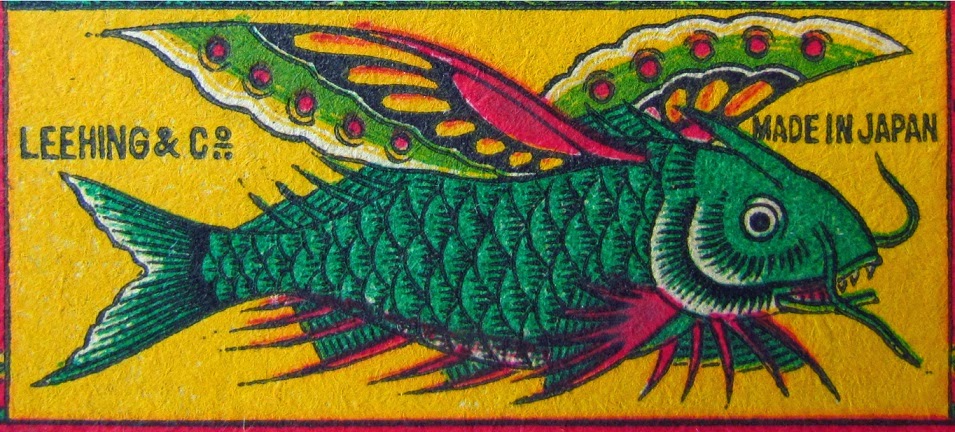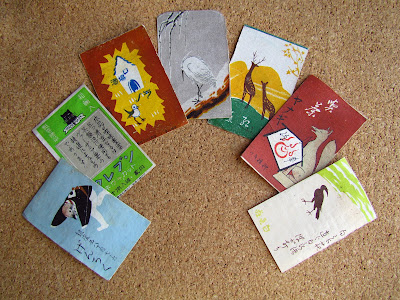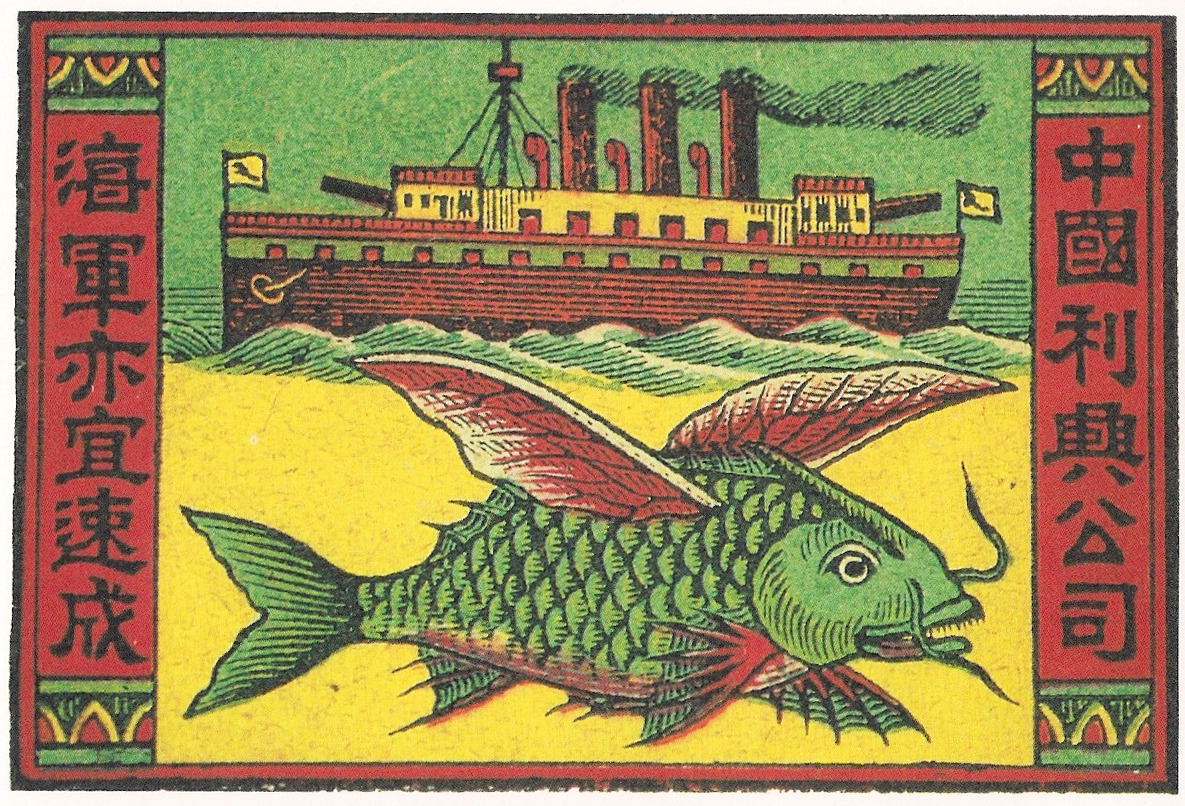 |
| 3 tigers 2 moon and 1 shooter |
Leehing

Friday, June 29, 2012
A few days ago I got these nice cute set of Kokeshi dolls labels...I realy like them! Together with them I got this odd Japanese double label that I realy don't know it's meaning
 |
| Kokeshi dolls |
Kokeshi (こけし kokeshi?), are Japanese dolls, originally from northern Japan. They are handmade from wood, have a simple trunk and an enlarged head with a few thin, painted lines to define the face. The body has a floral design painted in red, black, and sometimes yellow, and covered with a layer of wax. One characteristic of kokeshi dolls is their lack of arms or legs. The bottom is marked with the signature of the artist. Read more...
All rights reserved to Wikipedia
 |
| This label is made of a very special paper |
Monday, June 25, 2012
The rare amazingly beautiful Catfish set of labels of Leehing & Co. Kobe, Japan
Some of the labels are from the collection of my friend Yecheal Biskovitz: http://yecheal.webs.com/
I wish they were mine.....
 |
| Got it! |
Saturday, June 23, 2012
Japanese Patriotic labels of the Japanese war heroes Admiral Togo and General Oyama
On the morning of February 8, 1904, under the command of Vice-Admiral Togo Heihachiro, the main body of the Japanese Combined Squadrons appeared off Port Arthur (now Lushun, in North-East China), Russia's ice-free naval base in Manchuria, and home to its Pacific Fleet. Shortly after midnight the Japanese launched a surprise attack against Russia's Port Arthur naval base. At 0028 hours, February 9, 1904, the Japanese fired torpedoes at the moored and anchored Russian ships. Before the Russian gunners could open retaliatory fire, the best battleships of the Russian Pacific Fleet, Tsessarevitch and Retvizan, and also the first-rated cruiser Pallada, were hit. Thus began the Russo-Japanese War of 1904-05.
The conflict between Russia and Japan had its roots over the prior decade in the simultaneous ambitions of both Japan and Russia to develop 'spheres of influence' in Manchuria and Korea, mainly at the expense of China. After the surprise attack at Port Arthur, a series of quick Japanese victories, which astounded the world, soon followed. The Japanese were successful in their capture of Port Arthur (Jan., 1905), victorious under General Oyama at Shenyang (Feb.-Mar., 1905), and Admiral Togo's fleet defeated the Russian Baltic Fleet under Zinovi Rozhdestvenski, which had sailed a distance of over 18,000 miles to act as reinforcements, at Tsushima (May, 1905). The Russo-Japanese War ended, through the mediation of President Theodore Roosevelt, on September 5, 1905 with the signing of the Treaty of Portsmouth (New Hampshire).
The Russo-Japanese War brought recognition to Japan as a major world power. Russia's defeat in the war increased the Russian public's dissatisfaction with the Tsarist government and precipitated substantial social upheavals in 1905 - and ultimately led, as a consequence of the massive costs of the war, to the collapse of the Tsarist regime in 1917.
The conflict between Russia and Japan had its roots over the prior decade in the simultaneous ambitions of both Japan and Russia to develop 'spheres of influence' in Manchuria and Korea, mainly at the expense of China. After the surprise attack at Port Arthur, a series of quick Japanese victories, which astounded the world, soon followed. The Japanese were successful in their capture of Port Arthur (Jan., 1905), victorious under General Oyama at Shenyang (Feb.-Mar., 1905), and Admiral Togo's fleet defeated the Russian Baltic Fleet under Zinovi Rozhdestvenski, which had sailed a distance of over 18,000 miles to act as reinforcements, at Tsushima (May, 1905). The Russo-Japanese War ended, through the mediation of President Theodore Roosevelt, on September 5, 1905 with the signing of the Treaty of Portsmouth (New Hampshire).
The Russo-Japanese War brought recognition to Japan as a major world power. Russia's defeat in the war increased the Russian public's dissatisfaction with the Tsarist government and precipitated substantial social upheavals in 1905 - and ultimately led, as a consequence of the massive costs of the war, to the collapse of the Tsarist regime in 1917.
The early Japanese successes [in the Russo-Japanese War] made it easier for Japan, and harder for Russia, to obtain the foreign loans necessary for the continuation of hostilities - this was very much a "fight now, pay later" kind of war.
Source: http://www.rms-republic.com/conceal00.html All rights reserved.
 |
| Admiral Togo - the Naval hero |
The nice story behind the Antique ROCHE & CIE GRAND PRIX PARIS 1900 match candles holder
This beautiful antique box of match candles holder (I wish it was mine, but I am not willing to pay more than 100$ for it...), were said to be used by women in brothels, believe it or not....as a Timer!!. A man would
pay his dues and then she would light the candle. Once the candle went
out, the session was over. The candle is supposed to stay lit for
roughly seven minutes.
Thursday, June 21, 2012
Traditional Japanese Art deco designs - an Advertising Matchbox Labels dated 1920s-1930s

According to "Match World" virtual museum, advertising matches and premium matches started to be manufactured around 1900's.
In the beginning, a small space on the match was not considered to be effective for advertising, so only a few of them were manufactured. However, the advertising power began to be recognized gradually; soon match advertisement was a fad, and companies in all types of business employed it to give matches away competitively, which people welcomed very much since matches were necessity in every day life.
Read more about advertising on Matchboxes in Japan: http://server18.joeswebhosting.net/~xx9185/english/info/index.html
See more examples: http://server18.joeswebhosting.net/~xx9185/english/advertising/clothes.html
Masao Shimojima's, on his book "The Art of Japanese Matcbox Labels" describes the rise of cafes, bars, coffee shops and restaurants in the post-World War I period as war weary people sought to escape the pressures of life. They were "enthusiastic about visiting cafes or beer halls for an easy pastime and to seek temporary peace". This became even more pronounced after the Great Earthquake of 1923 when nudes and other risque artwork became popular on matchbox labels.
Young designers trained in Germany and Europe returned to Japan and produced elegant advertising for large companies such as Shiseido. Local artists and painters were both influenced by these national brands and spurred to produce more original designs. Many of these designs still showed the asymmetry and stylized flat shapes typical of Japanese woodblock prints. Some had amazingly clever use of only red and black ink colors while others used gold and silver metallic inks to add to their palette.
The Japanese matchbox labels are breathtaking in their stark beauty and simplicity: just a hand holding a glass or a dancing figure frozen in time. They were only low end ephemera but their reflection on the culture that produced them speaks of a world long gone.
 |
| From Grey to Blue |
 |
| Animals |
 |
| Pagodas |
 |
 |
| Black |
 |
| Red |
 |
| Yellow |
 |
| Light Blue |
Subscribe to:
Posts (Atom)








g~~60_1cut.jpg)
































